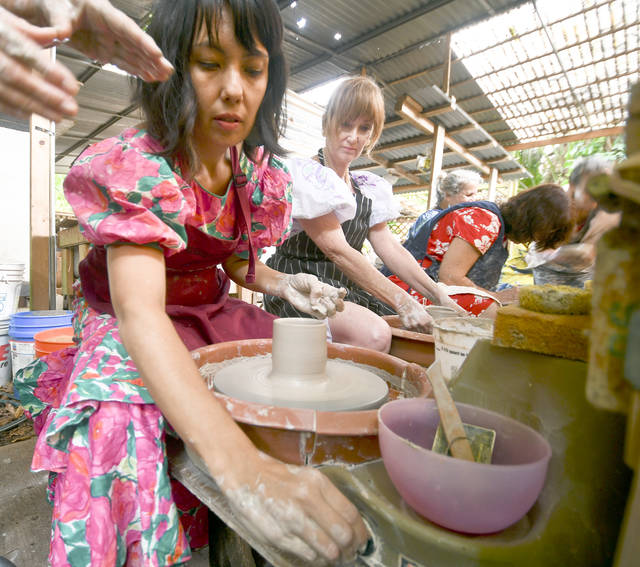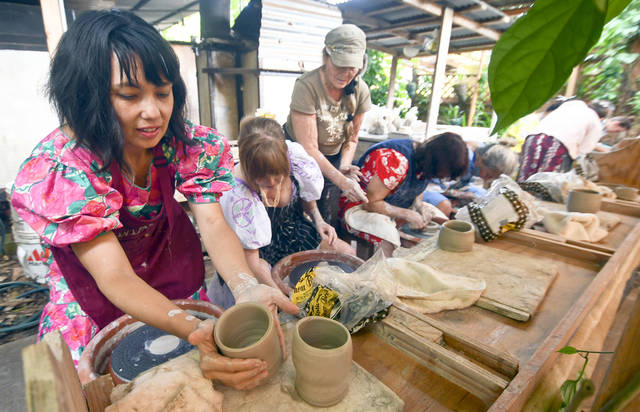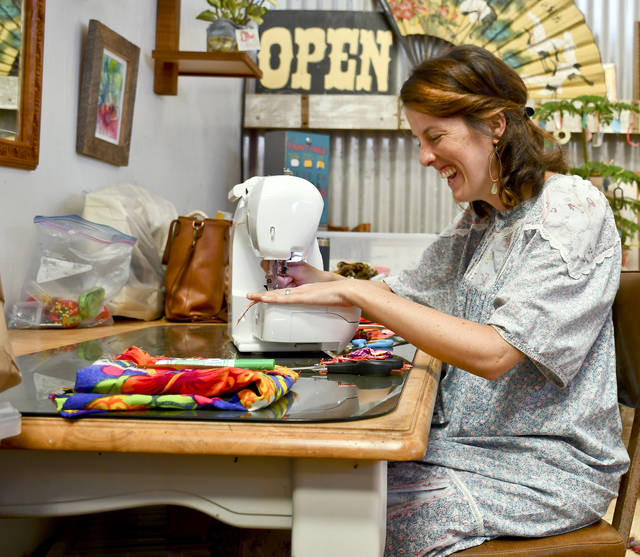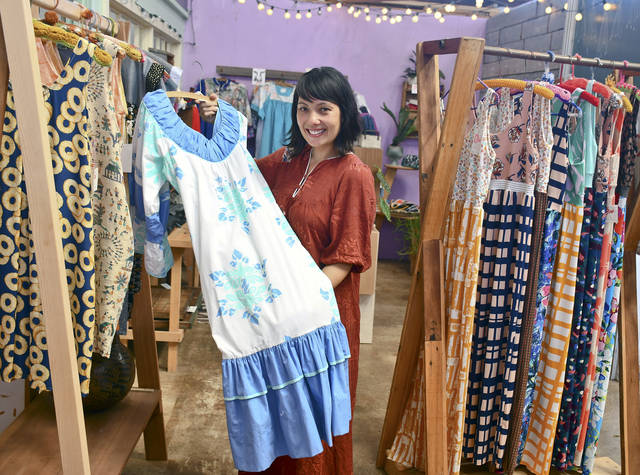Shannon Hiramoto

Dennis Fujimoto / The Garden Island
Shannon Hiramoto, wearing a mu‘umu‘u, slows the potter’s wheel while working on a cup at the Clayworks at Kilohana class in Puhi as part of her Mu‘umu‘u Month celebration.

Dennis Fujimoto / The Garden Island
Shannon Hiramoto, garbed in a mu‘umu‘u, places a completed cup for drying during the wheel throwing class at the Clayworks at Kilohana in Puhi. The outing with eight women wearing mu‘umu‘u is part of the Mu‘umu‘u Month celebration.

Dennis Fujimoto / The Garden Island
Brooke Nakatsukasa is garbed in a mu‘umu‘u while working on a sewing machine at the Machine Machine Apparel shop in the Lawai Warehouse.

Dennis Fujimoto / The Garden Island
Shannon Hiramoto shows off one of the mu‘umu‘u, the sale of which benefits the Kauai Historical Society.
There are just a few days remaining in January, but the racks containing mu‘umu‘u of various styles are full.
There are just a few days remaining in January, but the racks containing mu‘umu‘u of various styles are full.
Proceeds from the sale of the vintage clothing go to the Kauai Historical Society as part of January being Mu‘umu‘u Month, said Shannon Hiramoto, proprietor and seamstress at Machine Machine Apparel in the Lawai Warehouse.
“Through the year, I collect a lot and sell them in the shop during January to fundraise for the Kauai Historical Society,” Hiramoto said. “Last year, some $1,300 was raised. It is very fun to tie the garments back to a historical context, and wearing them brings history to life.”
During Mu‘umu‘u Month that is celebrating its fifth year, Hiramoto does several events, including a lei po‘o workshop, a mu‘umu‘u repair clinic, and several mu‘umu‘u field trips, including a tour of the historic Grove Farm Museum, and even throwing clay at a class at Clayworks at Kilohana in Puhi.
“This year, we have the most women ever participating, and it is officially become a real thing,” the seamstress said.
Why January as Mu‘umu‘u Month?
It’s the coldest month!
The start of the new year!
A great time for a fun personal challenge!
I got really interested in the mu‘umu‘u a few years ago when a friend’s mother gifted me a couple huge boxes full of vintage mu‘umu‘u. Knowing I like to sew, she thought I might want to take them apart and make them into something new.
I upcycled a few into tote bags, but it broke my heart to take such gorgeous dresses apart. I felt it wasn’t possible for me to repurpose these dresses into anything that would be cooler than the original.
I felt like I was taking history apart.
Talking to my family about how cool I thought they were, my sister and brother-in-law challenged me to wear them. So I did! I wore a different one everyday during January 2015.
If I was out of the house, I was in a mu‘umu‘u. I believe life is short, wear something long. And I declared January Mu‘umu‘u Month and posted photos every day with the hashtag #muumuumonth.
Statewide, women are donning their mu‘umu‘u to celebrate Hawaii’s unique fashion history and to pay homage to our tutu, aunties, and legacy of wahine that have come before.
Also…..it’s SO fun! A simple pleasure! An interesting way to step out of one’s comfort zone and begin the year off with a challenge.
This is the 5th annual Mu‘umu‘u Month, and more women than ever are rocking these dresses in their daily lives to celebrate Hawaii’s fashion history. It’s become quite a mu‘uvement statewide! Moreover, its a way to pay respect to the older generations of women who came before. It’s an interesting personal challenge that forces you to get out of your comfort zone in a very unconventional way.
I always say that to get out of your comfort zone you must get into the comfort zone (the mu‘umu‘u being one of the comfiest dresses ever created!) Some people might look at me funny when they see me shopping at Costco or hiking in Kokee in a bodacious Mamo — and that’s part of it, bringing an unexpected joy to others. Most people like to stop me and talk about their mom’s or auntie’s or tutu’s collections and their memories growing up.
It’s a great bonding experience. I love that we’re striking a chord and bringing history to life in such a sweet, simple, beautiful way!
To participate in Mu‘umu‘u Month, women can wear a mu‘u every once in a while, on Aloha Fridays, or every day — there are no rules. It is fun to participate in any capacity.
How does Machine Machine Apparel connect with the mu‘umu‘u?
My shop space houses a little nook that I endearingly call a Mu‘useum where I sell vintage mu‘umu‘u that I collect from garage sales and other people all year long.
During January I sell these, donating all the profits to the Kauai Historical Society because I see what they do as special and important. One day we’d like to partner up and do an interactive mu‘umu‘u-themed event.
In my shop I host an annual Mu‘umu‘u Repair Clinic so that women can tune-up their dresses as we prepare for Mu‘umu‘u Month and the year ahead.
Often the elastic in the sleeves has worn out and needs to be replaced. Many women purchase their mu‘umu‘u secondhand and need them to be taken in or hemmed. I help do little alterations like that. I’m against any sort of altering of the dresses to make them more modern or anything that affects their original integrity. These dresses are an endangered fashion species and a direct bridge to the past that you can actually use and experience.
What is a mu‘umu‘u?
When the missionaries arrived in Hawaii, they brought fabric and sewing machines to make modest dresses for Hawaiian women in a “Mother Hubbard” style, with high necklines, long sleeves, and long, flowing silhouettes. These dresses became known as holoku and were adopted by the upperclass and used for formal events and mission-house visits. Holoku went through a few design evolutions, sometimes becoming looser and more voluminous to be comfortable in our climate.
They consisted of a billowing skirt directly attached to a square yoke and puffed sleeves. Other times, the holoku was fitted close to the body with a long train trailing behind. They often featured a watch pocket at the hip.
The mu‘umu‘u, meanwhile, originated as a basic undergarment for the holoku (“mu‘u” meaning “to cut or shorten”). Many Hawaiian women liked the mu‘umu‘u for sleeping, swimming, and as a house dress.
Later, in the 1930s, with the availability of beautiful printed fabrics, the mu‘umu‘u became a proper dress of its own that could be worn in public.
Typical features of a mu‘umu‘u are puffy sleeves, long length, full, flowing body, a yoke, ruffles, pockets, colorful printed fabrics. The design evolution of this dress has been very playful and you’ll find designers of the past blended and omitted these elements as they pleased.
In the mid to late 20th century the mu‘umu‘u was the go-to dress for locals and tourists alike — for work, play, church and special events. There’s a great YouTube video on the history of these dresses, “Hawaiian Dress: The Holoku in Cultural Context,” by Linda Boynton Arthur.
What makes a mu‘u so popular?
I think they were popular because they are a great blend of both comfort and beauty.
There were dozens of design houses, and most were manufactured in Hawaii — some of the most popular were Mamo Howell, Bete, Andrade, Carol Bennett, Princess Kaiulani, Liberty House, Ui Maikai, Carol and Mary, Malia, Malama.
It is very interesting to look at all the ways these companies borrowed ideas and experimented with different styles — there’s a lot of playfulness and joy in these designs.
When I was growing up, mu‘umu‘u was the thing that every woman wore! During the last couple decades, the mu‘umu‘u has gotten a bad rap.
People think they’re out of style and outdated. Mainland pop culture makes fun of them. Yet most of us who have grown up here are very sentimentally attached to them. I feel that they’re eternally in-style!
How did your relationship with the mu‘umu‘u get started?
When I was young (in the ‘80s) I’d wear them all the time.
My grandmother would make my mother, sister and I matching ones. I still have some of those and am saving them for my daughter to wear.
Of course, time went on, trends changed, and they lost their significance. Looking back at old photo albums, it’s so amazing to see the women in my life wearing these dresses.
I have a big connection to one particular mu‘umu‘u that I found in Lihue Salvation Army last year.
It’s a sweet, red, purple and black Liberty House, short mu‘umu‘u that I bought for $4. When I looked at the Liberty House label, a name was handwritten on it — “Kamei” — my late great grandma’s last name.
My breath was taken away and I was determined to see if it truly was hers. I needed proof.
My mother and I searched all our photo albums, and while we found tons of photos of my great grandma in other mu‘umu‘u, we didn’t see this particular one.
I went home and my mother texted me later, she had found photos of great grandma posing in this sweet dress. I instantly knew where the photos were taken.
The next day I went to her old church, Hanapepe United Church of Christ, where her ashes are housed in the rear columbarium, and posed in the same exact location with the same dress.
Her mu‘u had brought me back to where she rests today. Florence Shizuko Kamei was an amazing woman, born in Kekaha, and lived until she was 108 years old. When she passed in 2013, she was the oldest person in the state. Coincidentally, when she was younger she was a mu‘umu‘u seamstress. I feel like this was her telling me that I’m on the right path and should continue following my passions.
What is ahead for you and the mu‘umu‘u?
More than ever, I feel dedicated to preserving this garment.
I’ve been documenting my own collection and all the mu‘umu‘u that I come across with the goal of creating an online digital archive.
I envision a crowdsourced website where users could explore the wide variety of mu‘umu‘u, searching by brand, color, print, style, era.
Also, a storytelling section for the ‘comu‘unity’ to share their personal narratives and memories. Perhaps, there are more stories like my great grandma’s mu‘u!
A digital archive is more important than a physical archive/collection, as these dresses need to be worn again, out in the world, getting the opportunity for a second life by today’s generation.
And let’s not forget Aloha Friday! One of my newest mantras is “Make Fridays Aloha Again.” While men have been steadfastly wearing aloha shirts on Fridays, we’ve not been so diligent with the mu‘umu‘u. I’d like to see the mu‘umu‘u Aloha Friday tradition return.
I’d love to see more women know about Mu‘umu‘u Month, and the mu‘umu‘u, so they can partake in the joy of rocking mu‘u — without feeling awkward.

